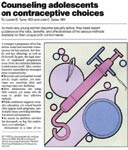Counseling adolescents on contraceptive choices
A review of how things have changed over 25 years when it comes to options available for teenagers about contraception and safe sex/abstinence.

In 2009, pediatricians continue to play an important role in their adolescent patients' reproductive health decision-making processes. In order to provide accurate information to teens, it is important to maintain knowledge of local and national statistics. The landscape of adolescent sexuality has changed over the last quarter century, mostly for the positive. Herein are some of the changes that have taken place since 1984, although not always in a forward direction:
– Fewer young teens are reporting sexual activity than their counterparts in the mid-1980s and 1990s. In 2002, approximately 13% of female and 15% of male 15- to 19-year-olds reported having had sex before 15 years of age. In 1995, these figures had been 19% and 21%.1 The authors reported that 18% of 13- to 14-year-old boys and 6% of girls reported intercourse in the 1980s.

– Sexually transmitted infections (STIs) are reported to occur in one out of every four teens between the ages of 14 and 19.3 Of the 18.9 million new STIs each year in the US, nearly half are diagnosed in females between 15 and 24 years of age.1 Appropriate use of condoms can help to prevent many of these cases. Vaccination with quadrivalent human papillomavirus (HPV) prior to sexual debut could potentially halve the number of STIs diagnosed in 15- to 19-year-olds.3
– There are 750,000 pregnancies each year in teen females between 15 to 19 years old, and 82% of them are unplanned.1 This number represents a significant decline from the 1.2 million reported by the authors in 1984, and a 36% decline since the peak rates from 1990 to 1991.1,2 In 2006, however, there was the first reported increase in births to 15- to 17-year-old females since '90/'91.2
– Access to confidential contraceptive services has greatly expanded over the last 30 years. The District of Columbia and 21 states give all minors the right to consent to contraceptive care, and 25 more permit access under certain conditions. These changes reflect rulings from the US Supreme Court that recognize an adolescent's right to privacy. Each state's current policies can be accessed at http://www.guttmacher.org/.4
– Balanced and well-designed sex education programs have been significantly affected by the infusion of federal funding for abstinence-only sex education (AOSE) programs. Despite data demonstrating the success of programs that teach both abstinence and contraception in delaying onset of sexual activity, preventing pregnancy and STIs, and the failure of AOSEs to change adolescent behaviors, federal funding for AOSE increased three-fold between 2001 and 2008.5,6 It's unknown if these changes are related to the recent increase in teen pregnancy rates.
Having "the talk" with teen patients
June 17th 2022A visit with a pediatric clinician is an ideal time to ensure that a teenager knows the correct information, has the opportunity to make certain contraceptive choices, and instill the knowledge that the pediatric office is a safe place to come for help.
Artificial intelligence improves congenital heart defect detection on prenatal ultrasounds
January 31st 2025AI-assisted software improves clinicians' detection of congenital heart defects in prenatal ultrasounds, enhancing accuracy, confidence, and speed, according to a study presented at SMFM's Annual Pregnancy Meeting.